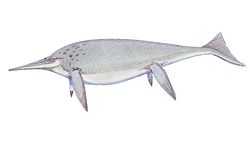Parvipelvia
Parvipelvia (Latin for "little pelvis" - parvus meaning "little" and pelvis meaning "pelvis") is an extinct clade of euichthyosaur ichthyosaurs from the Late Triassic to the early Late Cretaceous (middle Norian - Cenomanian) of Asia, Australia, Europe, North America and South America. Named by Ryosuke Motani, in 1999, it contains the basal taxa like Macgowania and Hudsonelpidia.[1] Maisch and Matzke (2000) found in their analysis seven synapomorphies that support Parvipelvia. They also found 10 synapomorphies that support the existence of post-Triassic clade of ichthyosaurs (all parvipelvians excluding Macgowania and Hudsonelpidia), for which the name Neoichthyosauria was found to be available.[2]
Phylogeny
Parvipelvia is a node-based taxon defined in 1999 as "the last common ancestor of Hudsonelpidia, Macgowania, Ichthyosaurus and all of its descendants".[1] Maisch and Matzke (2000) also defined Neoichthyosauria which is a node-based taxon originally named by P. Martin Sander in 2000, as "the last common ancestor of Temnodontosaurus trigonodon and Ophthalmosaurus icenicus and all of its descendants".[2] The cladograms below follows Motani (1999) and Maisch and Matzke (2000).[1][2]
References
|
|---|
| | | | Basal ichthyosaurs |
|---|
| Basal taxa | |
|---|
| | | Mixosauridae | Mixosaurinae | |
|---|
| Phalarodontinae | |
|---|
|
|---|
| | |
|---|
|
|---|
| Longipinnati | | |
|---|
| | |
|---|
| | | | | |
|---|
| | |
|---|
| ?Merriamosauridae | |
|---|
| | |
|---|
| Euichthyosauria | |
|---|
|
|---|
|
|---|
|
|---|
| Nomina dubia | |
|---|
| |
| | | |
|---|
| | |
|---|
| | |
|---|
| Neoichthyosauria | | | | |
|---|
| | |
|---|
| Eurhinosauria /
Leptonectidae | |
|---|
| | |
|---|
|
|---|
| |
| | | Related categories |
|---|
|
- Ichthyosaurs
- Marine reptiles
- Triassic reptiles
|
|
|


